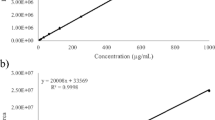Abstract
The main objectives of this study were (i) the optimization and the validation of a high performance liquid chromatographic method for the simultaneous determination of seven cholesterol oxidation products (COPs), (ii) the development of a reliable analytical protocol for their selective isolation from food samples, and (iii) the application to several foodstuffs. Baseline separation was achieved using a cyano-bonded high-performance liquid chromatography (HPLC) column and a mobile phase of n-hexane/2-propanol/acetone (97:1.5:1.5, v/v). The criteria studied for the choice of the optimum extraction procedure were the selectivity towards COPs and its efficiency in removing matrix interferences. Special attention was given to the stability of 7-keto under saponification conditions. The ideal procedure involved extraction of lipids from the food matrix with chloroform/methanol (2:1, v/v), alkaline hydrolysis with 1 M potassium hydroxide (KOH) solution in 60 % aqueous ethanol and subsequent enrichment of COPs with solid phase extraction using an NH2 column. COPs presented recoveries from 76 to 103 %.




Similar content being viewed by others
References
Baggio SR, Miguel AMR, Bragagnolo N (2005) Simultaneous determination of cholesterol oxides, cholesterol and fatty acids in processed turkey meat products. Food Chem 89:475–484
Boselli E, Caboni MF, Rodriguez-Estrada MT, Toschi TG, Daniel M, Lercker G (2005) Photoxidation of cholesterol and lipids of turkey meat during storage under commercial retail conditions. Food Chem 91:705–713
Brown AJ, Jessup W (1999) Oxysterols and atherosclerosis. Atherosclerosis 142:1–28
Busch TP, King AJ (2009) Artifact generation and monitoring in analysis of cholesterol oxide products. Anal Biochem 388:1–14
Busch TP, King AJ (2010) Stability of cholesterol, 7-ketocholesterol and β sitosterol during saponification: ramifications for artifact monitoring of sterol oxide products. J Am Oil Chem Soc 87:955–962
Chen YC, Chien JT, Inbaraj BS, Chen BH (2012) Formation and inhibition of cholesterol oxidation products during marinating of pig feet. J Agric Food Chem 60:173–179
Folch J, Lees M, Stanley GHS (1957) A simple method for the isolation and purification of total lipids from animal tissues. J Biol Chem 226:497–509
Georgiou CA, Kapnissi-Christodoulou CP (2013) Qualitative and quantitative determination of COPs in Cypriot meat samples using HPLC. Determination of the most effective sample preparation procedure. J Chromatogr Sci 51:286–291
Georgiou CA, Constantinou MS, Kapnissi-Christodoulou CP (2014) Sample preparation: a critical step in the analysis of cholesterol oxidation products. Food Chem 2013:918–926
Guardiola F, Dutta P C, Codony R, Savage G P (2002) Cholesterol and phytosterol oxidation products analysis, occurrence, and biological effects. AOCS Press
Lee HW, Chien JT, Chen BT (2006) Formation of cholesterol oxidation products in marinated foods during heating. J Agric Food Chem 54:4873–4879
Linseisen J, Wolfram G, Miller AB (2002) Plasma 7β-hydroxycholesterol as a possible predictor of lung cancer risk. Cancer Epidem Biomar 11:1630–1637
Mariutti LRB, Nogueira GC, Bragagnolo N (2008) Optimization and validation of analytical conditions for cholesterol oxides extraction in chicken meat using response surface methodology. J Agric Food Chem 56:2913–2918
Mazalli MR, Bragagnolo N (2009) Increase of cholesterol oxidation and decrease of PUFA as a result of thermal processing and storage in eggs enriched with n-3 fatty acids. J Agric Food Chem 57:5028–5034
Morán L, Andrés S, Bodas R, Prieto N, Giráldez FJ (2012) Meat texture and antioxidant status are improved when carnosic acid is included in the diet of fattening lambs. Meat Sci 91:430–434
Noguiera GC, Costa BZ, Crotti AEM, Bragagnolo N (2010) Synthesis of 7-hydroperoxycholesterol and its separation, identification, and quantification in cholesterol heated model systems. J Agric Food Chem 58:10226–10230
Otaegui-Arrazola A, Menendez-Carreno M, Ansorena D, Astiasaran I (2010) Oxysterols: a world to explore. Food Chem Toxicol 48:3289–3303
Park WT, Guardiola F, Park SH, Addis PB (1996) Kinetic evaluation of 3β-hydroxycholest-5-en-7-one (7-ketocholesterol) stability during saponification. J Am Oil Chem Soc 73:623–629
Raith K, Brenner C, Farwanah H, Muller G, Eder K, Neubert RHH (2005) A new LC/APCI-MS method for the determination of cholesterol oxidation products in food. J Chromatogr A 1067:207–211
Rodriguez-Carpena JG, Morcuende D, Petrón MJ, Estevez M (2012) Inhibition of cholesterol oxidation products (COPs) formation in emulsified porcine patties by phenolic-rich avocado (Persea americana Mill.) extracts. J Agric Food Chem 60:2224–2230
Rose-Sallin C, Huggett AC, Bosset JO, Tabacchi R, Fay LB (1995) Quantification of cholesterol oxidation products in milk powders using [2H7] cholesterol to monitor cholesterol autoxidation artifacts. J Agric Food Chem 43:935–941
Ryan L, O’Callaghan YC, O’Brien NM (2005) The role of the mitochondria in apoptosis induced by 7b-hydroxycholesterol and cholesterol-5b,6b-epoxide. Brit J Nutr 94:519–525
Saldanha T, Sawaya ACHF, Eberlin MN, Bragagnolo N (2006) HPLC separation and determination of 12 cholesterol oxidation products in fish: comparative study of RI, UV, and APCI-MS detectors. J Agric Food Chem 54:4107–4113
Sieber R (2005) Oxidised cholesterol in milk and dairy products. Int Dairy J 15:191–206
Ubhayasekera SJKA, Verleyen T, Dutta PC (2004) Evaluation of GC and GCMS methods for the analysis of cholesterol oxidation products. Food Chem 84:149–157
Vicente SJV, Sampaio GR, Ferrari CKB, Torres EAFS (2012) Oxidation of cholesterol in foods and its importance for human health. Food Rev Int 28:47–70
Acknowledgments
C.P.K.C. acknowledges the University of Cyprus for the support of this research. The authors would like to thank Ms. Andri Ioannou for her help in the performance of UV experiments and also for helpful discussions regarding the particular studies.
Conflict of Interest
Michalis S. Constantinou declares that he has no conflict of interest.
Christiana A. Georgiou declares that she has no conflict of interest.
Constantina P. Kapnissi–Christodoulou declares that she has no conflict of interest.
This article does not contain any studies with human or animal subjects.
Author information
Authors and Affiliations
Corresponding author
Rights and permissions
About this article
Cite this article
Constantinou, M.S., Georgiou, C.A. & Kapnissi-Christodoulou, C.P. Development of a Reliable Analytical Protocol for the Isolation of Cholesterol Oxidation Products—a Comparison of Different Lipid Extraction and Saponification Methods. Food Anal. Methods 8, 1499–1507 (2015). https://doi.org/10.1007/s12161-014-0034-1
Received:
Accepted:
Published:
Issue Date:
DOI: https://doi.org/10.1007/s12161-014-0034-1




